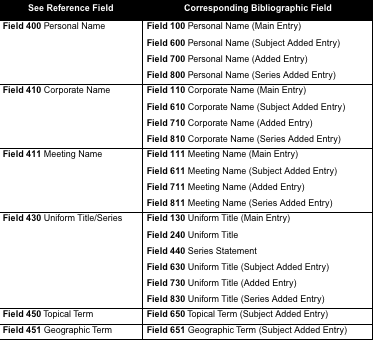Implementing Cross-References
Established headings are only a small part of Authority Control. While it is important to maintain accurate and consistent headings in your bibliographic records, Authority Control consists of much more. It is also a vital tool for patrons when searching your collection; it directs them to the correct titles if they search on an incorrect or “unestablished” heading. This is done with a See reference in the OPAC.
Just as important, Authority Control can suggest alternate or related headings in which the patron may be interested. For example, if patrons search for titles by Stephen King, they may also be interested in titles written under Stephen King’s pen name, Richard Bachman. With Authority Control, they would be directed to those titles with a See also reference.
Another advantage is that patrons can find all the titles and related titles in your collection with just one search. This is because all your headings are consistent and all your bibliographic records have been linked to those headings.
The authority records contain the link from the bibliographic field to the appropriate cross-reference. The authority records do not only contain established headings for a bibliographic field; they also contain fields with the appropriate cross-reference for that specific bibliographic field.
Implementing “See” References
The See reference directs a patron from an unestablished heading to the established heading. For example, a patron is searching for titles by the author Jean Plaidy. However, the patron searches for the titles using Jean Plaidy’s legal name, Eleanor Hibbert. Jean Plaidy is the established heading for this author; Eleanor Hibbert is the unestablished heading. The patron needs to be directed to the correct heading through the See reference.
Your authority record for Jean Plaidy would consist of the entry Jean Plaidy in MARC field 100 – Personal Name Heading. MARC field 100 is where the established heading is stored. In addition, this authority record would have an another field for the See reference; this field would have the entry Eleanor Hibbert.
Authority records have specific fields where the See reference is stored, based on whether the bibliographic field is a name, subject, or uniform title/series. Table 3 lists the See reference fields in an authority record.
TABLE 3

Using the Jean Plaidy example, your authority record would have the entry Jean Plaidy, 1906- in MARC field 100 – Personal Name Heading. The See reference Eleanor Hibbert, 1906- would be in MARC field 400 – See From Tracing Personal Name. The basic authority record would appear as shown in Figure 2:
FIGURE 2

Implementing “See Also” References
The See also reference directs a patron from an established heading to other related established headings. If a patron is searching for titles by the author Jean Plaidy, a See also reference directs the patron to other titles written by Jean Plaidy under the pen names of Victoria Holt and Philippa Carr.
By now, your authority record for Jean Plaidy consists of Jean Plaidy, 1906- in MARC field 100 (the established heading), and Eleanor Hibbert, 1906- in MARC field 400 (the See reference). This authority record also needs fields for the See also references to store the Victoria Holt and Philippa Carr entries.
Like See references, See also references are stored in a specific field in the authority record, based on whether the bibliographic field is a name, subject, or uniform title/series. Table 4 lists the See also reference fields in an authority record.
TABLE 4
|
See Also Reference Field
|
Corresponding Bibliographic Field
|
|
Field 500 Personal Name
|
Field 100 Personal Name (Main Entry)
Field 600 Personal Name (Subject Added Entry)
Field 700 Personal Name (Added Entry)
Field 800 Personal Name (Series Added Entry)
|
|
Field 510 Corporate Name
|
Field 110 Corporate Name (Main Entry)
Field 610 Corporate Name (Subject Added Entry)
Field 710 Corporate Name (Added Entry)
Field 810 Corporate Name (Series Added Entry)
|
|
Field 511 Meeting Name
|
Field 111 Meeting Name (Main Entry)
Field 611 Meeting Name (Subject Added Entry)
Field 711 Meeting Name (Added Entry)
Field 811 Meeting Name (Series Added Entry)
|
|
Field 530 Uniform Title/Series
|
Field 130 Uniform Title (Main Entry)
Field 240 Uniform Title
Field 440 Series Statement
Field 630 Uniform Title (Subject Added Entry)
Field 730 Uniform Title (Added Entry)
Field 830 Uniform Title (Series Added Entry)
|
|
Field 550 Topical Term
|
Field 650 Topical Term (Subject Added Entry)
|
|
Field 551 Geographic Term
|
Field 651 Geographic Term (Subject Added Entry)
|
In the Jean Plaidy example, two additional fields would be added for the two See also references. The See also references Victoria Holt, 1906- and Philippa Carr, 1906- would be entered in MARC field 500 – See Also From Tracing Personal Name. The basic authority record would appear as shown in Figure 3.
FIGURE 3
